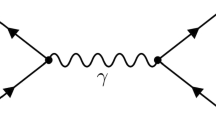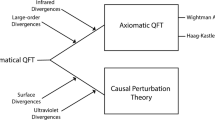Abstract
We propose a new computational method to understand the vacuum moduli space of (supersymmetric) field theories. By combining numerical algebraic geometry (NAG) and elimination theory, we develop a powerful, efficient, and parallelizable algorithm to extract important information such as the dimension, branch structure, Hilbert series and subsequent operator counting, as well as variation according to coupling constants and mass parameters. We illustrate this method on a host of examples from gauge theory, string theory, and algebraic geometry.
Similar content being viewed by others
References
J. Gray, Y.-H. He, V. Jejjala and B.D. Nelson, Vacuum geometry and the search for new physics, Phys. Lett. B 638 (2006) 253 [hep-th/0511062] [INSPIRE].
J. Gray, Y.-H. He, V. Jejjala and B.D. Nelson, Exploring the vacuum geometry of N = 1 gauge theories, Nucl. Phys. B 750 (2006) 1 [hep-th/0604208] [INSPIRE].
A. Hanany, E.E. Jenkins, A.V. Manohar and G. Torri, Hilbert Series for Flavor Invariants of the Standard Model, JHEP 03 (2011) 096 [arXiv:1010.3161] [INSPIRE].
Y.-H. He, P. Candelas, A. Hanany, A. Lukas and B. Ovrut eds. Computational Algebraic Geometry in String and Gauge Theory, Advances in High Energy Physics, Special Issue, Hindawi publishing (2012).
J. Gray, A. Hanany, Y.-H. He, V. Jejjala and N. Mekareeya, SQCD: a Geometric Apercu, JHEP 05 (2008) 099 [arXiv:0803.4257] [INSPIRE].
J. Gray, A Simple Introduction to Grobner Basis Methods in String Phenomenology, Adv. High Energy Phys. 2011 (2011) 217035 [arXiv:0901.1662] [INSPIRE].
D.A. Cox, J. Little and D. O’Shea, Ideals, Varieties, and Algorithms: An Introduction to Computational Algebraic Geometry and Commutative Algebra, 3rd ed., Undergraduate Texts in Mathematics, Springer-Verlag New York, Inc., Secaucus, NJ, U.S.A. (2007).
J.C. Faugère, A new efficient algorithm for computing groebner bases (F 4 ), J.Pure Appl. Algebra 139 (1999) 61.
J.C. Faugère. A new efficient algorithm for computing gröbner bases without reduction to zero (F 5 ), in ISSAC ’02: Proceedings of the 2002 international symposium on Symbolic and algebraic computation, ACM, New York, NY, U.S.A. (2002), pg. 75–83.
V.P. Gerdt, Involutive Algorithms for Computing Groebner Bases, math/0501111.
W. Decker, G.-M. Greuel, G. Pfister and H. Schönemann, Singular 3-1-3 — A computer algebra system for polynomial computations, (2011) [www.singular.uni-kl.de].
CoCoA team, CoCoA, a system for doing Computations in Commutative Algebra [cocoa.dima.unige.it].
D.R. Grayson and M.E. Stillman. Macaulay2, a software system for research in algebraic geometry [www.math.uiuc.edu/Macaulay2/].
W. Bosma, J. Cannon and C. Playoust, The magma algebra system i: the user language J. Symb. Comput. 24 (1997) 235.
J. Gray, Y.-H. He and A. Lukas, Algorithmic Algebraic Geometry and Flux Vacua, JHEP 09 (2006) 031 [hep-th/0606122] [INSPIRE].
J. Gray, Y.-H. He, A. Ilderton and A. Lukas, STRINGVACUA: a Mathematica Package for Studying Vacuum Configurations in String Phenomenology, Comput. Phys. Commun. 180 (2009) 107 [arXiv:0801.1508] [INSPIRE].
J. Gray, Y.-H. He, A. Ilderton and A. Lukas, A New Method for Finding Vacua in String Phenomenology, JHEP 07 (2007) 023 [hep-th/0703249] [INSPIRE].
D.J. Bates, J.D. Hauenstein, A.J. Sommese and C.W. Wampler, Bertini: Software for numerical algebraic geometry, [available at www.nd.edu/˜sommese/bertini].
J. Verschelde, Algorithm 795: Phcpack: a general-purpose solver for polynomial systems by homotopy continuation, ACM Trans. Math. Soft. 25 (1999) 251.
T. Gunji, S. Kim, M. Kojima, A. Takeda, K. Fujisawa and T. Mizutani, Phom: a polyhedral homotopy continuation method for polynomial systems, Computing 73 (2004) 57.
A.P. Morgan, A.J. Sommese and L.T. Watson, Finding all isolated solutions to polynomial systems using hompack, ACM Trans. Math. Softw. 15 (1989) 93.
T. Gao, T.Y. Li and M. Wu, Algorithm 846: Mixedvol: a software package for mixed-volume computation, ACM Trans. Math. Softw. 31 (2005) 555.
T.L. Lee, T.Y. Li and C.H. Tsai, Hom4ps-2.0, a software package for solving polynomial systems by the polyhedral homotopy continuation method, Computing 83 (2008) 109.
D. Mehta, Lattice vs. Continuum: Landau Gauge Fixing and ’t Hooft-Polyakov Monopoles, Ph.D. thesis, Australasian Digital Theses Program, University of Adelaide, Australia (2009).
D. Mehta, A. Sternbeck, L. von Smekal and A.G. Williams, Lattice Landau Gauge and Algebraic Geometry, PoS (QCD-TNT09) 025.
C. Hughes, D. Mehta and J.-I. Skullerud, Enumerating Gribov copies on the lattice, Annals Phys. 331 (2013) 188 [arXiv:1203.4847] [INSPIRE].
D. Mehta, Finding All the Stationary Points of a Potential Energy Landscape via Numerical Polynomial Homotopy Continuation Method, Phys. Rev. E 84 (2011) 025702 [arXiv:1104.5497] [INSPIRE].
M. Kastner and D. Mehta, Phase Transitions Detached from Stationary Points of the Energy Landscape, Phys. Rev. Lett. 107 (2011) 160602 [arXiv:1108.2345] [INSPIRE].
D. Mehta, J.D. Hauenstein and M. Kastner, Energy landscape analysis of the two-dimensional nearest-neighbor ϕ 4 model, Phys. Rev. E 85 (2012) 061103 [arXiv:1202.3320] [INSPIRE].
R. Nerattini, M. Kastner, D. Mehta and L. Casetti, Exploring the energy landscape of XY models, Phys. Revi. E 87 (2013) 032140 [arXiv:1211.4800] [INSPIRE].
M. Maniatis and D. Mehta, Minimizing Higgs Potentials via Numerical Polynomial Homotopy Continuation, Eur. Phys. J. Plus 127 (2012) 91 [arXiv:1203.0409] [INSPIRE].
J. Camargo-Molina, B. O’Leary, W. Porod and F. Staub, The Stability Of R-Parity In Supersymmetric Models Extended By U(1) B−L , Phys. Rev. D 88 (2013) 015033 [arXiv:1212.4146] [INSPIRE].
D. Mehta, Numerical Polynomial Homotopy Continuation Method and String Vacua, Adv. High Energy Phys. 2011 (2011) 263937 [arXiv:1108.1201] [INSPIRE].
D. Mehta, Y.-H. He and J.D. Hauenstein, Numerical Algebraic Geometry: A New Perspective on String and Gauge Theories, JHEP 07 (2012) 018 [arXiv:1203.4235] [INSPIRE].
Y.-H. He, D. Mehta, M. Niemerg, M. Rummel and A. Valeanu, Exploring the Potential Energy Landscape Over a Large Parameter-Space, JHEP 07 (2013) 050 [arXiv:1301.0946] [INSPIRE].
D. Martinez-Pedrera, D. Mehta, M. Rummel and A. Westphal, Finding all flux vacua in an explicit example, JHEP 06 (2013) 110 [arXiv:1212.4530] [INSPIRE].
J.D. Hauenstein and A.J. Sommese, Witness sets of projections, Appl. Math. Comput. 217 (2010) 3349.
J.D. Hauenstein and A.J. Sommese, Membership tests for images of algebraic sets by linear projections, Appl. Math. Comput. 219 (2013) 6809.
J.C. Migliore, Introduction to liaison theory and deficiency modules, Progress in Mathematics 165, Birkhäuser Boston Inc., Boston, MA,U.S.A. (1998).
J. Wess and J. Bagger, Supersymmetry and Supergravity, Princeton Series in Physics, Princeton University Press, Princeton, U.S.A. (1992).
M.A. Luty and W. Taylor, Varieties of vacua in classical supersymmetric gauge theories, Phys. Rev. D 53 (1996) 3399 [hep-th/9506098] [INSPIRE].
P.C. Argyres, An Introduction to Global Supersymmetry, lecture notes (2001) [http://www.physics.uc.edu/˜argyres/661/susy2001.pdf].
F. Buccella, J. Derendinger, S. Ferrara and C.A. Savoy, Patterns of Symmetry Breaking in Supersymmetric Gauge Theories, Phys. Lett. B 115 (1982) 375 [INSPIRE].
R. Gatto and G. Sartori, Consequences of the Complex Character of the Internal Symmetry in Supersymmetric Theories, Commun. Math. Phys. 109 (1987) 327 [INSPIRE].
C. Procesi and G. Schwarz, The geometry of orbit spaces and gauge symmetry breaking in supersymmetric gauge theories, Phys. Lett. B 161 (1985) 117 [INSPIRE].
E. Witten, Phases of N = 2 theories in two-dimensions, Nucl. Phys. B 403 (1993) 159 [hep-th/9301042] [INSPIRE].
G. Greuel and G. Pfister, A Singular Introduction to Commutative Algebra, Springer (2002).
D. Wang, Elimination methods, Texts and Monographs in Symbolic Computation, Springer-Verlag, Vienna, Austria (2001).
A.J. Sommese and C.W. Wampler, The numerical solution of systems of polynomials arising in Engineering and Science, World Scientific Publishing Company (2005).
J.D. Hauenstein and C.W. Wampler, Isosingular sets and deflation, Found. Comp. Math. 13 (2013) 371.
Z.A. Griffin, J.D. Hauenstein, C. Peterson and A.J. Sommese, Numerical computation of the Hilbert function of a zero-scheme, to appear in Springer Proceedings in Mathematics & Statistics.
D.J. Bates, J.D. Hauenstein, T.M. McCoy, C. Peterson and A.J. Sommese, Recovering exact results from inexact numerical data in algebraic geometry, Exp. Math. 22 (2013) 38.
A.K. Lenstra, H.W. Lenstra Jr. and L. Lovász, Factoring polynomials with rational coefficients, Math. Ann. 261 (1982) 515.
H. Ferguson and D. Bailey, A polynomial time, numerically stable integer relation algorithm, technical report (1991).
J.D. Hauenstein, A.J. Sommese and C.W. Wampler, Regeneration homotopies for solving systems of polynomials, Math. Comp. 80 (2011) 345.
N. Nekrasov and S. Shadchin, ABCD of instantons, Commun. Math. Phys. 252 (2004) 359 [hep-th/0404225] [INSPIRE].
M. Mariño and N. Wyllard, A Note on instanton counting for N = 2 gauge theories with classical gauge groups, JHEP 05 (2004) 021 [hep-th/0404125] [INSPIRE].
H. Nakajima and K. Yoshioka, Instanton counting on blowup. 1., Invent. Math. 162 (2005) 313 [math/0306198] [INSPIRE].
A. Hanany, N. Mekareeya and S.S. Razamat, Hilbert Series for Moduli Spaces of Two Instantons, JHEP 01 (2013) 070 [arXiv:1205.4741] [INSPIRE].
S. Benvenuti, A. Hanany and N. Mekareeya, The Hilbert Series of the One Instanton Moduli Space, JHEP 06 (2010) 100 [arXiv:1005.3026] [INSPIRE].
P. Candelas, A. Dale, C. Lütken and R. Schimmrigk, Complete Intersection Calabi-Yau Manifolds, Nucl. Phys. B 298 (1988) 493 [INSPIRE].
L.B. Anderson, Y.-H. He and A. Lukas, Heterotic Compactification, An Algorithmic Approach, JHEP 07 (2007) 049 [hep-th/0702210] [INSPIRE].
P. Candelas, X. de la Ossa, Y.-H. He and B. Szendroi, Triadophilia: A Special Corner in the Landscape, Adv. Theor. Math. Phys. 12 (2008) 429 [arXiv:0706.3134] [INSPIRE].
L. Blum, F. Cucker, M. Shub and S. Smale, Complexity and real computation, Springer-Verlag, New York, U.S.A. (1998).
J.D. Hauenstein and F. Sottile, alphaCertified: Software for certifying numerical solutions to polynomial equations [www.math.tamu.edu/˜sottile/research/stories/alphaCertified].
J.D. Hauenstein and F. Sottile, Algorithm 921: alphaCertified: Certifying solutions to polynomial systems, ACM TOMS 38 (2012) 28.
D. Mehta, J.D. Hauenstein and D.J. Wales, Certifying the Potential Energy Landscape, Chem. Phys. 138 (2013) 171101 [arXiv:1302.6265] [INSPIRE].
Author information
Authors and Affiliations
Corresponding author
Additional information
ArXiv ePrint: 1210.6038
Rights and permissions
About this article
Cite this article
Hauenstein, J., He, YH. & Mehta, D. Numerical elimination and moduli space of vacua. J. High Energ. Phys. 2013, 83 (2013). https://doi.org/10.1007/JHEP09(2013)083
Received:
Revised:
Accepted:
Published:
DOI: https://doi.org/10.1007/JHEP09(2013)083




